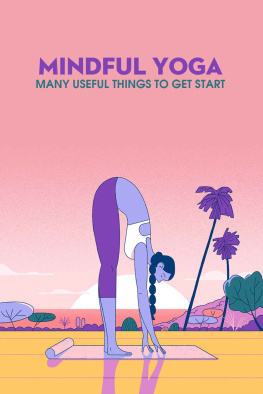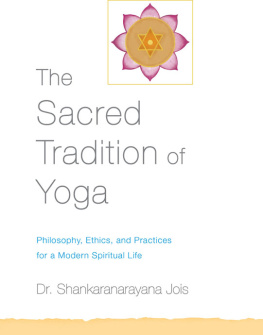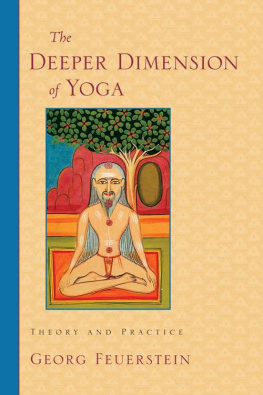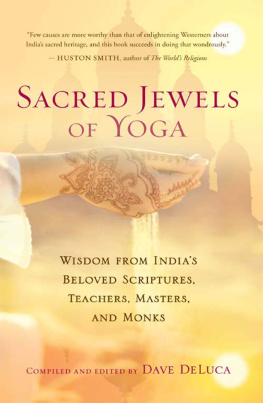LIBERATION THROUGH
YOGA
CAIO MIRANDA

AuthorHouse
1663 Liberty Drive, Suite 200
Bloomington, IN 47403
www.authorhouse.com
Phone: 1-800-839-8640
2009 Leda Miranda and Lia Miranda. All rights reserved.
English translation 2009 by Jos M. Dionisio.
No part of this book may be reproduced, stored in a retrieval system, or transmitted by any means without the written permission of the copyright holders.
First published by AuthorHouse 3/6/2009
ISBN: 978-1-4343-8285-6 (sc)
Library of Congress Control Number: 2008904424
Printed in the United States of America
Bloomington, Indiana
This book is printed on acid-free paper.
Edited and translated from the Portuguese
3rd edition (1963)
I dedicate this book to those anxious to find the Path, and who will be the Masters of tomorrow. They will understand the great love that inspired it.
Caio Miranda
Contents
First Stage: Yama
Second Stage: Niyama
Third Stage: Asana
Fourth Stage: Pranayama
Fifth Stage: Pratyahara
Sixth Stage: Dharana
Seventh Stage: Dhyana
Eighth Stage: Samadhi
Foreword
As I start this book, I send my most cordial salutations to all those who, in any religion or in silence and retreat, fight for the cause of spirituality, sincerely seeking the Way.
I tell them not to become discouraged when confronted with possible mistakes and eventual failures, for the trail that leads to the Path is known to be steep and rough. Occasionally, the hiker is sent to the bottom of the abyss for taking a single false step. But the fall, instead of separating him from the journey, should renew his strength to proceed, now more resolute and experienced, in the dignifying effort to reach the finishing line.
Many of those who today occupy salient positions in the Great Hierarchy fell before, successive times. They did not grow weaker or give up. They came from several places, by different routes, more or less rugged, because all paths are good, and not only good, as they are all necessary.
Receive, therefore, brothers of all doctrines and cults, the warmth of my solidarity, so that you may understand and feel my desire for these teachings to serve, progressively, as a reinforcement of your opinions and beliefs.
Preface
Free from the bondage of his actions is the man who, by Spiritual Knowledge, cut the knots that linked him to the fruits of his acts and who, by the Law of Knowledge, destroyed his doubts and illusions.
--Bhagavad Gita, Part IV, verse 41
It is not our intention to present something new with the present book. Our work consisted of a compilation that took place over many years of study and sincere observations, with the objective of offering a book that summarizes the elementary teachings of Yoga to those who seek the Way.
Many times, in our own journey in search of the Path, we were asked about an elementary book that would give the curious layman or the unsatisfied mystic a global vision of the spiritual problem and of the human conquests in this obscure field. We could not indicate any book. The specific literature available to the public is extremely fragmentary and difficult to understand for those who do not have a solid base of theosophical knowledge. The books for sale generally cover isolated parts of the subject or, when they are not sectarian, they are abstruse in such a way that they discourage the continuity of the study. Meanwhile, a great wave of spirituality overwhelms the world, especially the Americas, which have a most grandiose esoteric destiny.
Our intention is to bring this unpretentious book to the neophytes of this part of the globe, with the sole virtue of being understood by anyone. In it, you will find extracts from the works of several researchers. We are certain that they will be pleased to see their observations confirmed and diffused. The fruit of our own research, which is easily identifiable, represents our desire to bring to the students of the subject something to be discussed and criticized.
We sought to present here an expositionconcatenated and, as much as possible, simpleof what we think is the indispensable knowledge base for the study and practice of Yoga, this wonderful science still so little known in the West. Besides the foregoing motives, we had the aspiration of contributing, even in a minimal way, to the improvement of the inner side of each human being, thus contributing to the establishment of a peaceful and happy world, where all people love each other as brothers.
We do not make an apology for this or that doctrine. We think that the right to evolve and liberate oneself is not denied to any being. The possibility of redemption does not lie exclusively in a certain religious or philosophical system, but solely in the sincerity with which each one of them is embraced and realized. Only with purity of intentions can we find the Way that leads to the identification of our divine part. This identification or final union is the Yoga, realizable in any doctrine.
If our work can in any way contribute to attenuate the anguishes of this afflicted world in which we live, awakening in some hearts the sincere desire to liberate oneself from the chains of pain and rebirths, we will have accomplished the mission we proposed to ourselves, since pain is not inherent to life but an unavoidable consequence of our way of living.
We used in the text, preferentially, the original Sanskrit terms, as it becomes extremely difficult to find in our idiom other terms that could accurately translate them.
With time and continued reading, you will become familiar with them without the need for a special glossary.
May peace be with you and all beings.
Preface of the English Edition
The story goes that the powerful Alexander the Great, thrilled to meet the famous philosopher, asked if there was any favor he might do for him. Diogenes, who was sitting on the ground, replied, Alexander, stand out of my sunlight.
This book was first published in Brazil in 1960. It is being published in English for the same reason it was originally written: to present a simple and yet comprehensive idea of what Yoga is. Its message is timeless and addressed to anyone, regardless of culture or belief: the liberation of man is in the depths of his being. This is the same direction of the Ancient Greek aphorism inscribed in the forecourt of the Temple of Apollo at Delphi: Know thyself. And the Greeks were probably echoing the wisdom they inherited from times immemorial.
This same wisdom also asserts that once ignorance is conquered, human pain will dissipate like mist on a spring morning. Meanwhile, our philosophical systems, religions, and scientific knowledge continue to be manifestly insufficient. They do not provide a view of the universe that is accurate and broad enough to promote human conduct based on the ethics of responsibility, which would liberate us from the impasse we find ourselves in.
The debate between materialists and idealists continues to be relentless, inconclusive, and fruitless. Yet, on the margin of this, an ancient and fundamental knowledge upon which these two opposing views rest will gradually be uncovered and brought to light, ending the speculations of interpreting reality. This book offers an overview of this millenary knowledge, which is Yoga.
Most of the readily available literature on Yoga consists of Hatha-Yoga, which involves physical exercises (most of which were introduced in the twentieth century) that promote the health and well-being of its practitioners through systematic and regular practice. Yoga, however, is much more than this; its ultimate objective is the union of man with the divine essence that inhabits the intimacy of his being.
Next page







